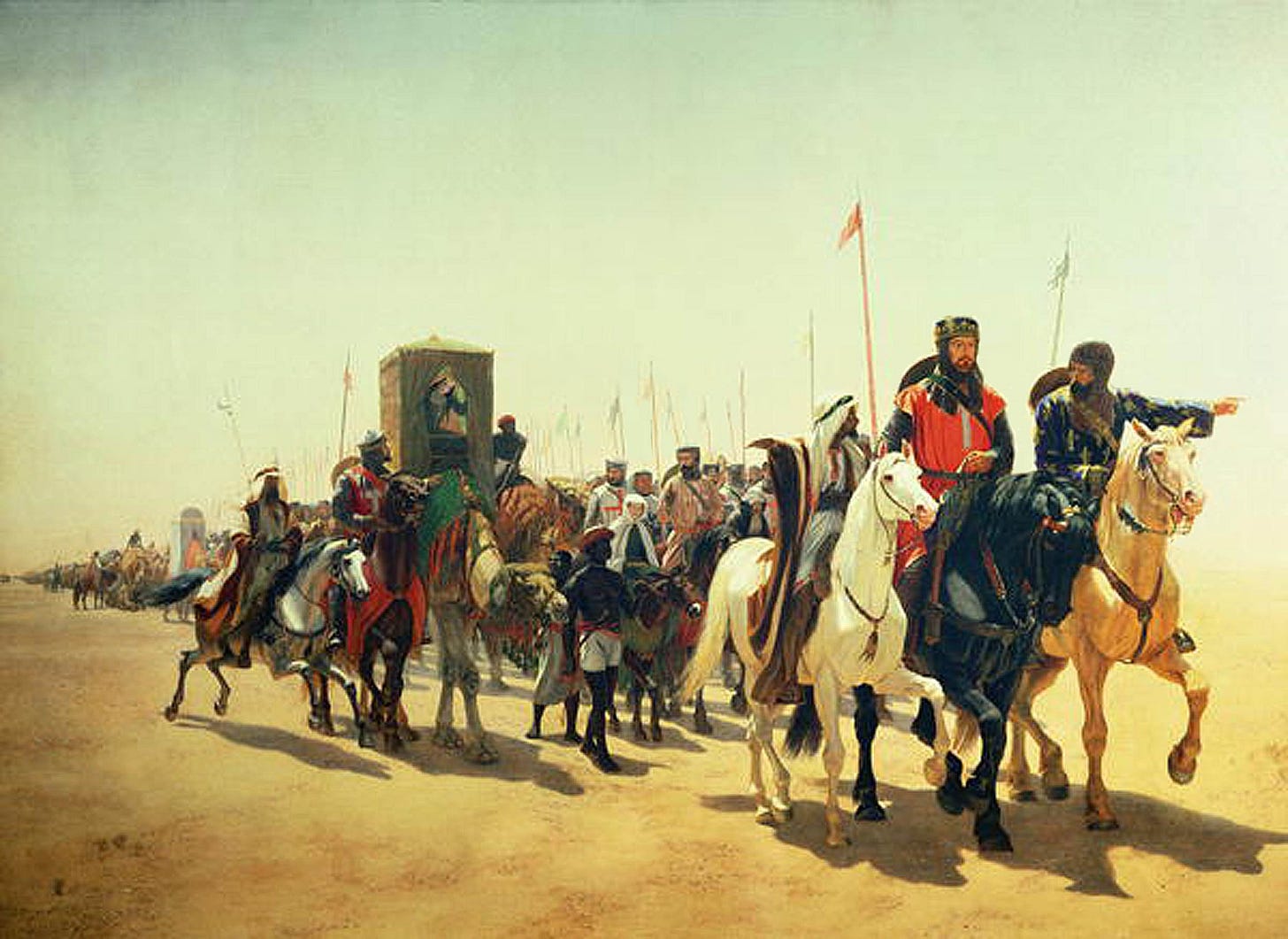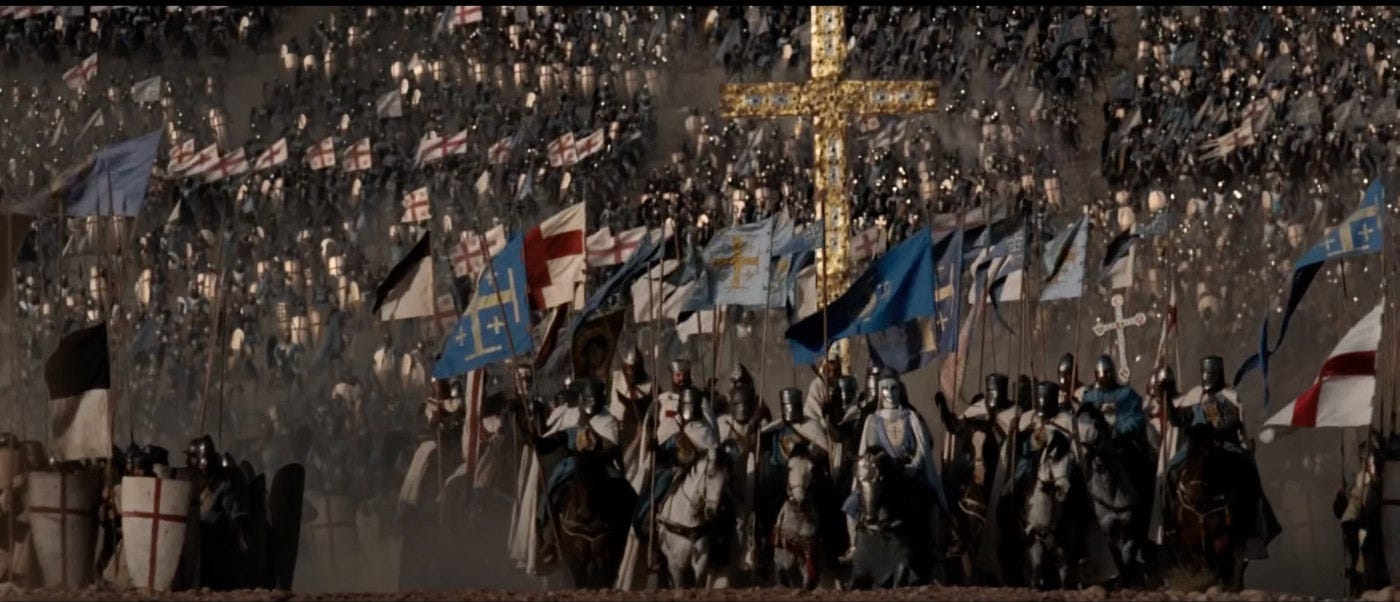Some past articles have explored the realities of medieval travel in general: travel by land and travel by sea. And we have explored all the difficulties in planning a crusade: recruiting, logistics, food, money.
Today we’re exploring a Crusader army on the march. But first, some music:
—A modern interpretation of a medieval melody by the Chœur de la Joyeuse Garde
Crusader marching, routes and distances
Crusaders did a lot of marching. The First Crusade marched from points in France or Germany across the continent, headed for Constantinople/Istanbul. From there they crossed into modern day Turkey, then Syria, Lebanon and Israel. It took them more than a year of marching to arrive in Jerusalem.
Richard the Lionheart’s mother Eleanor of Aquitaine and her then-husband King Louis VII of France marched from Metz, in north-western France, all the way to Jerusalem, a distance of at least 2500 miles. This also took them over a year!
Not until the Third Crusade, led by Richard, did forces sail to the Holy Land. Undoubtedly his mother advised against the march, as the Second Crusade had extraordinary difficulty simply getting to the Holy Land. This removed a vast amount of marching — though they still did a great deal of it once they landed at Acre.
March formations
Kings, nobles, and knights typically rode. Usually they would have war horses (“destrier”, “charger”), which they did not ride for transit, as well as smaller, lighter horses (“coursers”, “rounceys”, “palfreys”) for transit or sometimes for specific battle conditions.
Foot soldiers, commoners, camp followers, pretty much everyone else, walked.
Large group marches typically followed well known routes, often following Roman roads when in Europe. These roads were often not that wide, perhaps 12-18 feet.

In larger armies, the march would be organized by units - typically a knight would have a unit that he was responsible for, and they would march in a group.
A typical formation would have leaders at the front (in the “vanguard”), followed by units, often organized in preparation for battle, if they were near the enemy. The baggage train, usually consisting of wagons or pack mules carrying tents, supplies, food, water, maybe a million arrows, spare weapons, siege engines, and so on, would be at the rear. From contemporary histories we have a great deal of information about Richard’s march from Acre to Arsuf, and he changed his formations frequently based on defensive strategy (that march, and the following Battle of Arsuf warrant their own blog post at some point).
About the word march: it is unlikely the army was marching in “lock step” the way you might consider a parade march in a modern army. It was more likely a shambling mass, roughly sticking together.
The size of the march
We have a lot of detail about Richard’s march from Acre to Arsuf. His forces numbered between 10,000 and 20,000 men. From that we can estimate the size of the train. Spoiler: the battle train winding down a road could easily be 5-10 miles in length, depending on the size of the force. Kind of staggering, isn’t it?
There are some interesting sites for estimating the relationship between crowd size and area, many developed in reaction to recent controversies about political crowd sizes. For example, MapChecking shows crowd densities on a Google map. Perhaps you’ve been to Paris and walked the Champs-Élysees? It is about 1.5 miles long and perhaps 80 feet wide (much wider than a Roman road), and MapChecking suggests the Champs-Élysees would handle 10,000-20,000 people in a light crowd—which would not account for camp followers, baggage, horses, siege engines, food and supply wagons and the rest.

Dr. Keith Still has developed visualizations of the “person per square meter” metric one might use to convert a crowd size to area or vice versa:

If you really want to geek out, this article has a ton of fascinating detail about march logistics. While it is in regard to the American Civil War era, it maps pretty well, and it concludes that a train of 3000 infantrymen and their supplies on a 13 foot wide road would be 1.5 miles long.1 I read on a different blog somewhere that the Union battle train at the Battle of Gettysburg was 75,000 men and 17 miles long.
So for Richard’s march from Acre to Arsuf, a train of 5-10 miles sounds about right. Unsurprisingly, the Muslim forces that controlled the area at that time were not happy the Crusaders were there and battled to keep them out. So, for much of that march they were under attack.
Conditions
What were conditions like for the common foot soldier in such a march?
You probably wake up at 5 in the morning, cook and eat your breakfast, then pack up (Richard took to waking people to march in the middle of the night to avoid the heat). Nobles are sleeping in tents, so those have to be packed up as well.
It’s going to be hot and thirsty work. During the summer temperatures would soar to 104°F (~40°C). You’re carrying your own supplies, perhaps 50 pounds of gear. If you’re in the back of the train, you wait an hour or so while the front gets marching (the accordion effect you see at a stoplight), then the road is slowly churned to mush or mud and choking dust fills the air.
What do you do to keep your spirits up when you’re marching? Why, sing, of course. Roving bands of preachers and callers would ride up and down the line, singing songs or doing call-and-response chants. Not the earthy, ribald chats I associate with an army on the move, but religious songs, religious chants. A common chant was “Sanctum Sepulchre Adjuva”—Latin for ‘help the Holy Sepulchre’—as retaking Jerusalem and the Holy Sepulchre was the goal of the crusade. The crusaders certainly relied on their faith to keep them going, their belief that they were doing God’s work, however we today might feel about the Crusades. And the music: we’ll talk more about crusader music in a later post!
Richard also flew his banner2 mounted on the top of a tall pole, itself mounted on a wheeled wagon, so that everyone could see it, follow it, and be encouraged.
Should the train come to a river, everyone would halt while the water barrels were brought forward and filled, before the deluge of men fouled the water.
Speaking of bad water, illness was a constant problem for crusaders—dehydration and dysentery in particular. It is often estimated that more crusaders died of disease than battle.
Eventually the front of the train stops, likely in mid-afternoon, so everyone has time to catch up, and make camp for the night, and eat.
What did the Crusaders eat on the march?
Richard’s Third Crusade brought a great deal of food with it: hard tack (very dry biscuits), meal, cheeses, beans, and salted meat. Records indicate Richard brought 15,000 cured pig carcasses with him when he left England (as well fifty thousand horseshoes, perhaps a million arrows, pepper, cumin, spices, and many other supplies). Contemporary histories say that when his fleet left Messina each boat carried a year’s worth of food (which seems implausible, but…).
Once they arrived in the Holy Land, the Crusaders did adapt to local food. This wonderful article talks about research done on cesspits and associated fecal matter found at the Crusader castle of Apollonia very close to the location of the Battle of Arsuf, to see what they ate. One of the surprises was one of my personal favorites, figs! Also wheat, barley, lentils, legumes, chickens, and lots and lots of figs!
And at the end of the day, sleep. Ah, comfortable sleep. Well, no.
As each night came round, a sort of reptile attacked us, commonly called tarrentes, which creep on the ground, and have most venomous stings. As the day comes on, they are harmless; but on the approach of night, they used their stings most pertinaciously, and those they stung were instantly swelled with the venom, and tortured with pain. … At last, the more observant, perceiving that the reptiles were frightened away by loud sounds, raised a great noise at their approach by beating and clashing their helmets and shields together; also by beating against their seats, poles, casks, flagons, basins, platters, caldrons, and whatever household ware they could lay hands on to make a sufficient sound; and by these sounds they drove away the reptiles.
— from Itinerary of Richard I and others in the Holy Land, a contemporary history written around 1220.
So, you’re sleeping on the hard ground, rolled in a blanket maybe, getting stung or bitten by tarantulas or scorpions, meanwhile people are tasked with creating an unholy din in hopes the creatures leave you alone. Meanwhile you expect to be attacked at any moment.
All in all, not a pleasant experience :)
Next time, we’re going to talk a bit more about Crusader music, and…Lady Gaga. Seriously.
https://acoup.blog/2019/10/06/new-acquisitions-how-fast-do-armies-move/







